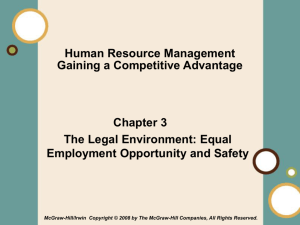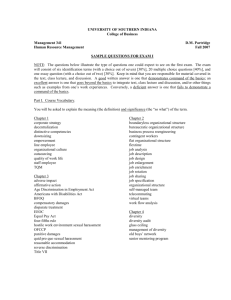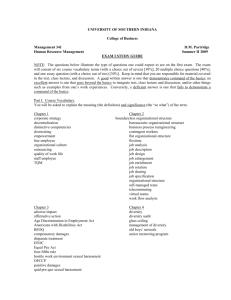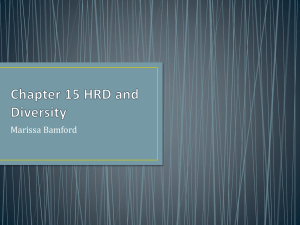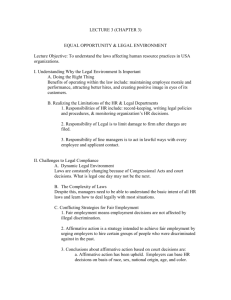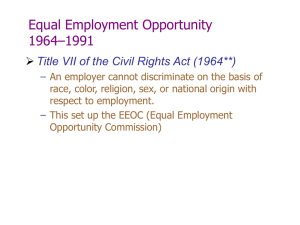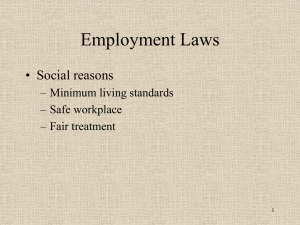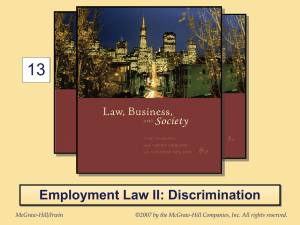Human Resource Management 5/e
advertisement
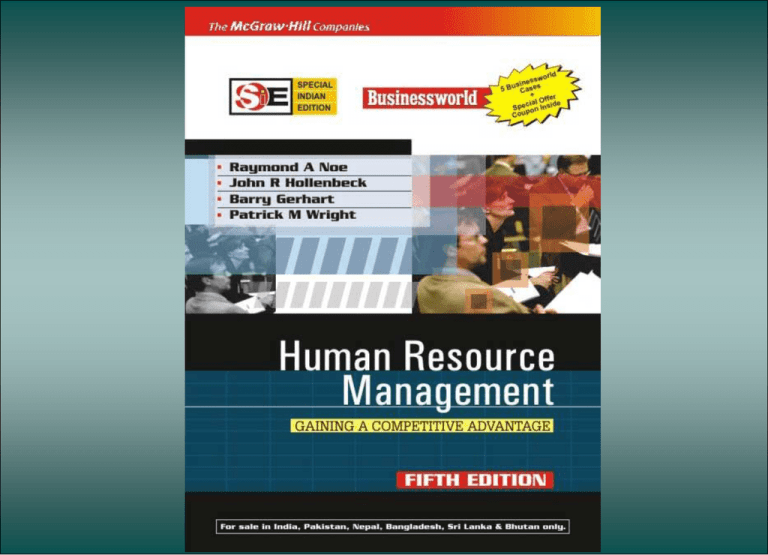
1 Chapter 3 The Legal Environment: Equal Employment Opportunity and Safety After reading this chapter, you should be able to: Identify the three branches of government and the role each plays in influencing the legal environment of human resource management. List the major federal laws that require equal employment opportunity and the protections provided by each of these laws. Discuss the roles, responsibilities, and requirements of the federal agencies responsible for enforcing equal employment opportunity laws. Identify the four theories of discrimination under Title VII of the Civil Rights Act and apply these theories to different discrimination situations. Chapter 3 The Legal Environment: Equal Employment Opportunity and Safety Identify behavior that constitutes sexual harassment and list things that an organization can do to eliminate or minimize it. Discuss the legal issues involved with preferential treatment programs. Identify the major provisions of the Occupational Safety and Health Act (1970) and the rights of employees that are guaranteed by this act. The Legal System in the United States Legislative Branch Judicial Branch Executive Branch Three Branches The Legal System in the United States The legislative branch of the federal government consists of the House of Representatives and the Senate. These bodies enact laws that govern many HR activities. The executive branch consists of the president of the United States and the regulatory agencies the president oversees. The judicial branch consists of the federal court system, which is made up of three levels. U.S. district courts and quasi-judicial administrative agencies. The U.S. Court of Appeals The Supreme Court Equal Employment Opportunity Equal employment opportunity refers to the government's attempt to ensure that all individuals have an equal chance for employment, regardless of race, color, religion, sex, or national origin. Constitutional Amendments: 13th Amendment - abolished slavery 14th Amendment - forbids states from denying equal protection of the laws Congressional Legislation The Reconstruction Civil Rights Acts (1866 and 1871) These acts were attempts to further the goal of eradicating slavery. Patterson v. McClean Credit Union Equal Pay Act of 1963 - requires that men and women in the same organization who are doing equal work must be paid equally. Title VII of the Civil Rights Act of 1964 - makes it illegal for an employer to "fail or refuse to hire or discharge any individual because of the individual's race, color, religion, sex, or national origin. Congressional Legislation The Age Discrimination in Employment Act of 1967 - prohibits discrimination against employees over the age of 40. Vocational Rehabilitation Act of 1973 - covers federal contractors and requires them to engage in affirmative action for disabled individuals. Vietnam Era Veteran’s Readjustment Act of 1974 - requires federal contractors to take affirmative action toward employing Vietnam veterans. Congressional Legislation Civil Rights Act of 1991 - allows compensatory and punitive damages when discrimination has been intentional or reckless. Americans with Disabilities Act of 1990 Protects individuals with disabilities from being discriminated against in the workplace by prohibiting discrimination in all employment practices. Requires that "reasonable accommodations" be made as long as they do not present an "undue burden" upon the employer. Executive Orders Executive Order 11246 affirmative action targets for women and minorities Executive Order 11478 government employment policies based on merit and fitness Enforcement of Equal Employment Opportunity Two agencies responsible for the enforcement of these laws and executive orders: Equal Employment Opportunity Commission Office of Federal Contract Compliance Programs Equal Employment Opportunity Commission Three major responsibilities: Investigating and resolving discrimination complaints Gathering information Issuing guidelines Office of Federal Contract Compliance Programs Three components: The utilization analysis compares the race, sex, and ethnic composition of the employer's work force with that of the available labor supply. The employer must develop specific goals and timetables for achieving balance in the workforce. They specify the percentage of women and minorities that an employer seeks, and the date by which that percentage is to be attained. Employers must develop a list of action steps, which are the written affirmative plan that specifies what an employer plans to do to reduce underutilization of protected groups. The OFCCP annually audits government contractors. Types of Discrimination - Show intent? Disparate Treatment - yes Disparate Impact - no Reasonable Accomodation - yes - Prima facie case - member of protected group - statistical disparity - failure to be accomodated - Employer’s defense - show BFOQ - show job relatedness - job relatedness and business necessity - Plaintiff’s rebuttal - reason a pretext - other ways exist - Damages - compensatory/ - equitable relief punitive - McDonnell Douglas - Griggs v. Duke v. Green Power Hopkins v. Price Wards Cove v. Waterhouse Atonio - Key litigation - compensatory/ punitive - Walmart Disparate Treatment Disparate treatment exists when individuals in similar situations are treated differently based upon race, color, religion, sex, national origin, age, or disability status. Bona fide occupational qualifications (BFOQ) - A characteristic that is necessary, rather than preferred, for a job. McDonnell Douglas Corp v. Green Disparate Impact Disparate impact occurs when a facially neutral employment practice disproportionately excludes a protected group from employment opportunities. Four-fifths rule - a test has disparate impact if the hiring rate for the minority group is less than four-fifths (80 percent) of the hiring rate for the majority group. Standard deviation rule - uses actual probability distributions to determine adverse impact. Wards Cove Packing Co. v. Antonio Griggs v. Duke Power Reasonable Accommodation Reasonable Accommodation - places a special obligation on an employer to affirmatively do something to accommodate an individual’s disability or religion. Religion and Accommodation - Individuals who hold strong religious beliefs find that some of the observations and practices of their religion come into contact with work duties. Disability and Accommodation - Employers are not only to refrain from discrimination (ADA) but they are also obligated to take affirmative steps to accommodate individuals who are protected under the act. Retaliation for Participation and Opposition Title VII states that employers cannot retaliate against employees for either "opposing" a perceived illegal employment practice or "participating in a proceeding,” related to an alleged illegal employment practice. However, employees do not have an unlimited right to talk about how racist or sexist their employers are. The courts tend to frown on employees whose activities result in a poor public image for the company unless those employees attempted to use the organization’s internal channels. Current Issues Regarding Diversity and Equal Employment Opportunity Issues regarding diversity are increasingly important. Sexual Harassment Affirmative Action and Reverse Discrimination Outcomes of Americans with Disabilities Act Sexual Harassment Sexual harassment refers to unwanted sexual advances. Quid pro quo harassment occurs when some type of benefit or punishment is made contingent upon the employee submitting to sexual advances. Bundy v. Jackson A hostile working environment occurs when someone's behavior in the workplace creates an environment that makes it difficult for someone of a particular sex to work. Ron Clark Ford of Amarillo, TX, and Babies ‘R’ Us Sexual Harassment Three critical conditions for Sexual Harassment cases: The plaintiff cannot have "invited or incited" the advances Harassment must have been severe The court must determine the liability of the organization for actions of its employees Preventative steps for firms include development of a policy statement, training in inappropriate behaviors, development of a reporting mechanism, and disciplinary policy. Affirmative Action and Reverse Discrimination Affirmative Action was conceived of as a way of taking extra effort to attract and retain minority employees. Imposed quota programs are negotiated with the EEOC and hold a certain number of positions for minorities or women. The entire debate over affirmative action continues to invoke attention. Many people consider quotas or preferential treatment as reverse discrimination. Outcomes of the Americans with Disabilities Act Under ADA, a firm must make "reasonable accommodation" to a physically or mentally disabled individual unless doing so would impose "undue hardship.” Consequences of this act: There has been increased litigation The kinds of cases being filed do not reflect Congressional intent The act was passed to protect people with major disabilities, however, major disabilities account for less than 4 percent of claims. The law has not resulted in a major increase in the proportion of people with disabilities who are working. Employee Safety Employee safety is regulated by both the federal and state governments. The Occupational Safety and Health Act (OSHA) authorizes the federal government to establish and enforce occupational safety and health standards for all places of employment engaging in interstate commerce. The General duty clause of OSHA states that an employer has an overall obligation to furnish employees with a place of employment from recognized hazards. Employee Rights Under OSHA Employees have a right to: 1. Request an inspection. 2. Have a representative present at an inspection. 3. Have dangerous substances identified. 4. By promptly informed about exposure to hazards and be given access to accurate records regarding exposures. 5. Have employer violations posted at the work-site. OSHA Inspections, Citations, and Penalties OSHA inspections are conducted by specially trained agents of the Department of Labor called compliance officers. If a compliance officers believe that a violation has occurred, they issue a citation to the employer specifying the practice or situation that violates the act. Criminal and civil penalties may be assessed for willful violations that kill an employee. Safety Awareness Programs Safety awareness programs attempt to instill symbolic and substantive changes to a safety program. There are three primary components of a safety awareness program: Identifying and Communicating Job Hazards The job hazard analysis technique breaks jobs down into basic elements that are then rated for their potential for harm. Technic of Operations Review (TOR) focuses on past accidents and their causes. Reinforcing Safe Practices Promoting Safety Internationally
